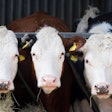
A comparative life cycle assessment (LCA) by Evonik has further demonstrated the ecological advantages of using its feed amino acids and feeding concepts compared with common animal nutrition practices.
The global LCA analyzed the environmental impact of feeding swine, broiler chickens, and laying hens. The study was audited and certified by TÜV Rheinland according to ISO 14040 and 14044 in second quarter 2021.
"Our system solution – based on a balanced amino acid profile, low crude protein content, and our amino acid products – can contribute significantly to reducing the environmental footprint of livestock farming, without compromising animal welfare," says Dr. Emmanuel Auer, head of Evonik's Animal Nutrition business line. "And we need to use this scope to meet the animal protein needs of a growing world population without overstretching natural resources."
The Animal Nutrition business line is part of Evonik's life sciences division Nutrition & Care, which is all about developing sustainable solutions for a better life for people and animals. Auer: “It is impossible to meet the challenges of our times with single products. This is why we concentrate all our knowledge and experience on developing targeted system solutions.”
In 2010, Evonik pioneered its first TÜV-certified comparative LCA for feed supplementation with the essential amino acids methionine, lysine, threonine, and tryptophan. In 2015, a second followed, which also included valine. Both times, feeds without amino acid supplementation served as a comparison.
"Today, amino acid supplementation is common practice in many parts of the world," says Dr. Jan-Olaf Barth, head of the Efficient Nutrition product line at Evonik. That was taken into account in the current study, as were regional differences in feed composition. "This enables us to provide our customers with even more targeted advice," says Barth.
In the new LCA, the environmental impact of species, and the developmentally appropriate feeding of swine, broiler chickens, and laying hens with balanced amino acid profiles and low crude protein content, was evaluated according to the following criteria: global warming, acidification and eutrophication potential; blue water consumption; land occupation; and respiratory inorganics.
The analysis included feed raw material production, animal husbandry and manure treatment emissions.
"We have found that our feeding concepts and amino acids can have significant effects in reducing climate change and nitrogen-based emissions," says Dr. Michael Binder, responsible for Sustainability Development in the Animal Nutrition business line. "Their application can reduce acidification, eutrophication and the release of respiratory inorganic substances induced by ammonia."
The study also demonstrates another advantage of low protein feeding regimes: the option to use regional raw materials with a lower environmental footprint.


















